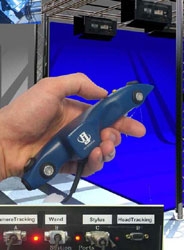 |
Abstract: Visual Acceptance Evaluation of Soft Shadow Algorithms for Virtual TV Studios
Hüseyin Ayten, Jens Herder, and Wolfgang Vonolfen. Visual Acceptance Evaluation of Soft Shadow Algorithms for Virtual TV Studios, 13th International Conference on Human and Computer, Hamamatsu/Aizu-Wakamatsu/Duesseldorf, December, 2010.
Shadows in computer graphics are an important rendering aspect for spatial objects. For realtime computer applications such as games, it is essential to represent shadows as accurate as possible. Also, various tv stations work with virtual studio systems instead of real studio sets. Especially for those systems, a realistic impression of the rendered and mixed scene is important. One challenge, hence, is the creation of a natural shadow impression. This paper presents the results of an empirical study to compare the performance and quality of different shadow mapping methods. For this test, a prototype studio renderer was developed. A percent- age closer filter (pcf) with a number of specific resolutions is used to minimize the aliasing issue. More advanced algorithms which generate smooth shadows like the percentage closer soft shadow (pcss) method as well as the variance shadow maps (vsm) method are analysed. Different open source apis are used to develop the virtual studio renderer, giving the benefit of permanent enhancement. The Ogre 3D graphic engine is used to implement the rendering system, benefiting from various functions and plugins. The trans- mission of the tracking data is accomplished with the vrpn server/ client and the Intersense api. The different shadow algorithms are compared in a virtual studio environment which also casts real shadows and thus gives a chance for a direct comparison throughout the empirical user study. The performance is measured in frames per second.
Keywords:
soft shadows, virtual studio, mixed reality
Video:
Visual Acceptance Evaluation of Soft Shadow Algorithms for Virtual TV Studios (60 MB) >>
|
 |
